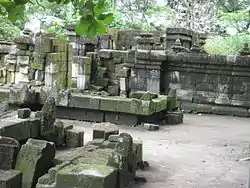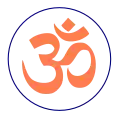| Kedulan ꦏꦺꦣꦸꦭꦤ꧀ | |
|---|---|
 The ruins of Candi Kedulan | |
| General information | |
| Architectural style | Hindu candi |
| Town or city | near Yogyakarta (city), Yogyakarta |
| Country | Indonesia |
| Completed | circa 9th century |
| Client | Sailendra or Mataram Kingdom |
Kedulan temple (Indonesian: Candi Kedulan; Javanese: ꦕꦤ꧀ꦝꦶꦏꦺꦣꦸꦭꦤ꧀, romanized: Candhi Kédhulan) is the ruin of a 9th-century Hindu candi located not far from Sambisari temple. The temple is located in Tirtomartani village, Kalasan subdistrict, Sleman Regency, Yogyakarta, Indonesia. The style and architecture bear striking similarities to the nearby Sambisari temple. And just like Sambisari, the temple compound is buried around 6 metres (20 ft) below the present surface, as the result of lava flow from the past eruption of Mount Merapi in the north.[1]
The temple complex took form as a compound enclosed in stone walls, with some parts still buried underground. Within the enclosure, there are four temples; one main temple facing east, and three smaller ancillary temples (candi perwara) in front of the main temple on the eastern side in a row running north to south. The style and layout are quite similar to Sambisari temple; however, Sambisari temple faces west, and is located around 2.5 kilometres (1.6 mi) to the southwest.
History
The main temple was accidentally discovered in 24 November 1993, when a group of volcanic sand miners quarried the land. The land was communally owned by village. Subsequently, archaeological excavations were commenced, led by BP3 Yogyakarta. After digging 6–7 metres (20–23 ft) deep, the ruins of the temple's main building were uncovered. The temple floor plan is a square measuring 13.7 metres (45 ft) on each sides, and the height of the main building is 8.009 metres (26.28 ft) tall.[1] Currently, the temple is in disrepair; some parts are still buried and some stones are missing.
In 2017, the archaeological study and reconstruction project were in progress and by early 2018, the temple reconstruction entered the anastylosis phase. The restoration of the entire Kedulan Temple complex was expected to be completed by the end of 2018.[2][3][4]
See also
References
- 1 2 Indonesia, Perpustakaan Nasional Republik Indonesia / National Library of. "Candi Kedulan (Yogyakarta) - Kepustakaan Candi". candi.perpusnas.go.id (in Indonesian). Archived from the original on 2017-12-05. Retrieved 2017-11-20.
- ↑ Ajie, Stefanus (17 February 2018). "Kedulan Temple restoration enters anastylosis phase". The Jakarta Post. Retrieved 2018-03-12.
- ↑ Balai Pelestarian Cagar Budaya Yogyakarta (Indonesia), (film producer.) (2018), Candi Kedulan : menelusuri warisan Rakai Watukara Dyah Balitung : film dokumenter, retrieved 31 July 2023
- ↑ Mengembalikan kemegahan bangunan suci di Tlu Ron : pelestarian Candi Kedulan (Cetakan pertama ed.), Kementerian Pendidikan dan Kebudayaan, Direktorat Jenderal Kebudayaan, Balai Pelestarian Cagar Budaya D.I. Yogyakarta, 2019, retrieved 31 July 2023
